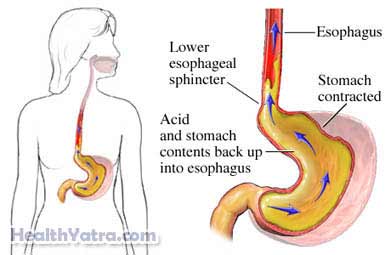परिभाषा
Gastroesophageal reflux (GER) is a back up of acid or food from the stomach to the esophagus. The esophagus is the tube that connects your mouth and stomach. GER is common in infants. It causes them to spit up. Most infants outgrow GER within 12 months.
GER that progresses to esophageal injury and other symptoms is called gastroesophageal reflux disease (GERD). GERD is pain and swelling in the esophagus. It is caused by the regular flow of acidic stomach contents into the esophagus. Children who have birth defects or disorders of the brain and spine have an increased risk of GERD.
GERD can cause serious health issues. The sooner it is treated, the better the outcome.

का कारण बनता है
GERD is caused by the regular flow of stomach acid into the esophagus. It is not always clear why the acid backs up. The reasons may vary from person to person. There may be a genetic link in some GERD.
Acid is kept in the stomach by a valve. The valve opens when food comes in. It should close to keep in the food and acid. If this valve does not close properly, the acid can flow out of the stomach. The valve may not close because of:
- Problems with the nerves that make the valve open or close
- Increased pressure in the stomach—such as too much food in the stomach or pressure on the abdomen
- Irritation in the stomach or muscles of the valve
- Problem with the valve itself
- Swelling and irritation of the esophagus
जोखिम कारक
Factors that increase your child’s chance of developing GERD include:
- जन्म दोष
- Neurological impairment
- समय से पहले जन्म
- Down syndrome or intellectual disability
- Cerebral palsy
- सिर पर चोट
- Hiatal hernia
- खाद्य प्रत्युर्जता
- मोटापा
- कुछ दवाएँ
- तंबाकू के धुएं के संपर्क में आना
- Abnormal pressure to the valve
- Narrow or short esophagus
- Delayed emptying of the stomach
लक्षण
Symptoms of GERD include:
- Difficulty swallowing or choking with feedings
- Apnea or blue skin, which occurs when not enough oxygen gets to the airways
- Refusal to eat
- Increased mouth secretions
- Regurgitation or vomiting
- खूनी उल्टी
- Weight loss or poor weight gain
- Pain in the abdomen or chest
- Frequent pneumonia or respiratory problems
- Coughing or wheezing
- कर्कशता
- Arching back while feeding
- Irritability or restlessness while feeding
निदान
Your doctor will ask about your child’s symptoms and medical history. A physical exam will be done. Your child may need to see a specialist. The doctor may specialize in disorders of the stomach and intestines.
Images may need to be taken of your child’s stomach and esophagus. This can be done with:
- Upper GI series
- Nuclear medicine scan
अन्य परीक्षणों में शामिल हो सकते हैं:
- Swallowing evaluation
- Upper endoscopy with biopsy
- 24-hour pH monitoring to keep track of acid levels
उपचार
There are three goals for treatment. The first is to prevent injury to the esophagus. The second is to make sure the child is eating enough. The third goal is to keep the backed up food and acid from getting into the lungs. This will require a team approach. Your child may work with the pediatrician, specialized doctors, and a variety of therapists.
अपने बच्चे के लिए सर्वोत्तम उपचार योजना के बारे में अपने डॉक्टर से बात करें। उपचार के विकल्पों में शामिल हैं:
Feeding Management
It is important that your child is able to get the food needed for good health. GERD can make it difficult for your child to eat. Your doctor may recommend a feeding tube. This is a tube that is inserted through your child’s nose to your child’s stomach. It will deliver the nutrients your child needs. The feeding tube will also decrease the risk of choking and ease the stress of feeding.
दवाएं
Most GERD in children can be relieved with lifestyle changes. Medication may be given if your child’s GERD doesn’t improve. The medication can help to decrease acid in the stomach and help the esophagus heal. Medication options may include:
- Histamine-2 receptor drugs—to decrease acid production and promote healing
- Proton pump inhibitors—also decreases acid production and promote healing
Many of these are over-the-counter medications that are available in liquid or powder form.
प्रक्रियाओं
Surgery or endoscopy may be recommended with more severe cases.
The most common surgery is called fundoplication. During this procedure, a part of the stomach will be wrapped around the stomach valve. This makes the valve stronger. It should prevent stomach acid from backing up into the esophagus. This surgery is often done through small incisions in the skin.
रोकथाम
While the cause of GERD is largely unknown, you can take steps to control the condition in your child by:
- Keeping the medical team informed of changes in your child’s health
- Learning how to care and use the feeding tube
- Keeping a diary of your child’s symptoms and progress
